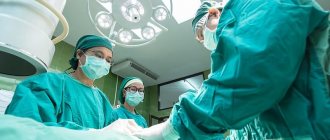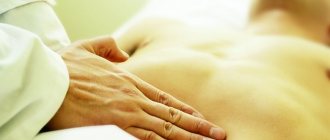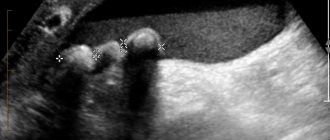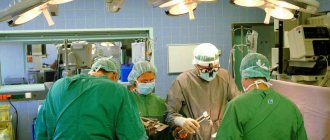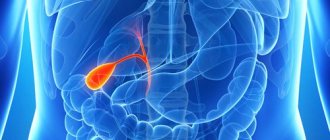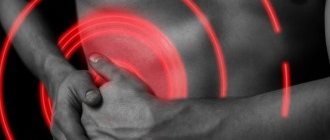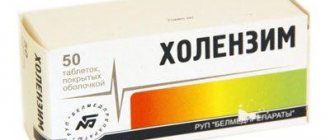In a healthy person, excrement is light or dark brown in color; if its shade becomes bright yellow or greenish, mucus impurities appear, this indicates that bile has entered the feces. Hologenic diarrhea develops when there is an excessive release of bile acids into the cavity of the colon against the background of impaired absorption of these substances and accelerated movement of feces. Bile in the stool may occur in people with Crohn's disease, short bowel syndrome, and gallbladder disease.
Causes of diarrhea
Yellow diarrhea occurs when there is a serious disorder of the digestive tract. Normally, only the feces of an infant under 2 months contain bile. In an adult, such inclusions are a deviation and are regarded as a symptom of certain diseases.
Cause of bile in stool:
- Crohn's disease;
- biliary dyskinesia;
- dysbacteriosis;
- pancreatitis;
- helminthic infestation;
- chronic cholecystitis;
- use of enzyme preparations;
- malabsorption syndrome;
- cholelithiasis;
- sphincter of Oddi insufficiency;
- long-term use of antibiotics;
- operations in the small intestine - short bowel syndrome;
- after removal of the gallbladder;
- food or alcohol poisoning.
Diarrhea with the release of bile appears when there is an excessive intake of bile acids into the colon, their reflux into the small intestine between meals, or impaired absorption of nutrients. Inflammatory processes and the proliferation of pathogenic microflora have a negative effect on peristalsis. After alcohol, in case of food poisoning, the body is not able to process bile acids, which enter the intestines undigested and provoke the development of hologenic diarrhea.
With malabsorption syndrome, the absorption of nutrients by the villi of the small intestine is impaired, and insufficient digestion of food occurs. The disease is accompanied by the appearance of neutral fat, mucus and bile in the stool.
If dyskinesia or biliary obstruction develops, it can also cause hologenic diarrhea, which alternates with constipation. With a long course of the disease, bile stagnates, a stone forms, and an inflammatory process develops (cholecystitis, cholangitis). This condition is accompanied by acute or bursting pain in the right hypochondrium, nausea, and vomiting.
Why is the stool light after gallbladder removal?
Hundreds of suppliers bring hepatitis C medications from India to Russia, but only M-PHARMA will help you buy sofosbuvir and daclatasvir, and professional consultants will answer any of your questions throughout the entire treatment.
The gallbladder is an internal organ of the biliary system, which also includes the liver, the main tasks of which are accumulation, bringing to the required concentration and timely release of bile produced by the liver into the digestive tract (when food enters there).
Bile is produced by special liver cells called hepatocytes. Then, with the help of the bile ducts, this secretion is delivered to the bladder and accumulates there until food is consumed. The liver produces bile around the clock, and its amount daily can reach up to two liters.
The main purpose of bile is the primary emulsification and breakdown of heavy animal fats, as well as stimulating intestinal motility.
The gallbladder looks like a sac-like hollow reservoir that is pear-shaped. It is able to alternate cycles of relaxation and contraction. Just like other internal organs, it can also be affected by various pathologies, the treatment of which, alas, is often only possible through surgery.
Clinical signs
The main characteristic symptom of hologenic diarrhea is loose stools of bright yellow or green color, abdominal pain, and flatulence. Discomfortable sensations predominate in the iliac region of the right hypochondrium and intensify with palpation. Such signs are caused by the accumulation of bile acids, which can be released along with feces from the cecum and other parts of the large intestine. Bile diarrhea is characterized by a long course, but progression of the pathology is not observed.
In healthy people, the gallbladder contains a large amount of bile, this substance is produced by hepatocytes (liver cells), it is necessary for the breakdown of fats that enter the body during meals. If the functioning of this organ is disrupted, acids in their original form enter the intestines, change the color of feces, cause irritation of the mucous membranes, against which diarrhea develops with the release of bile, a frequent urge to defecate occurs, and jaundice is sometimes observed.
With malabsorption syndrome, an admixture of mucus and fat is found in the feces, feces have a strong, unpleasant odor, and the act of defecation is accompanied by copious release of gases.
An adult loses his appetite and is bothered by nausea and abdominal pain. Over a long period of time, the pathology leads to loss of body weight, fatigue, brittle hair and nails, dry skin, stomatitis, and inflammation of the gums.
Causes of diarrhea in the postcholecystectomy period
After undergoing cholecystectomy, the patient is deprived of the gallbladder, and diarrhea is often noted during the recovery period. This occurs due to the production of bile by the liver and its passage through the gallbladder into the duodenum when food is consumed.
When the gallbladder is removed, this disrupts the natural passage of bile; it is constantly released in new conditions, which causes diarrhea. The concentration is reduced, which does not allow proper breakdown of fats. This is why indigestion and yellow diarrhea occur when diet is violated.
The patient should eat small portions, excluding foods rich in fat from the daily diet. The time intervals between meals should not be more than five hours. You cannot skip the next portion, since the secreted bile will greatly irritate the mucous membranes in the intestines.
Laboratory diagnostics
To determine the diagnosis, a study of the composition of feces is carried out - a coprogram. Feces contain a large amount of bile acids, which should be excreted no more than 100 mg/g per day. In patients, this figure increases several times.
If the patient is worried about diarrhea with bile, pain in the iliac region of the abdomen, a biochemical blood test is prescribed. Based on its results, an increase in the concentration of liver enzymes ALT, AST, alkaline phosphatase, and bilirubin can be detected. The blood contains high levels of low-density cholesterol, DPA (diphenylamine - an indicator of inflammation), and acute phase proteins. In general clinical analysis, an increased ESR is noted. When the pancreas is involved in the inflammatory process, an increased level of β-amylase, leukocytes, and protein is diagnosed in the urine.
For a comprehensive diagnosis, stool is analyzed for the presence of parasites. The worm can cause blockage of the bile ducts with further inflammation (cholecystitis).
According to individual indications, intestinal colonoscopy is performed to assess the condition of the mucous membranes.
A gastroenterologist also prescribes an ultrasound of the abdominal cavity, during which he examines the gallbladder, liver, and pancreas. Patients are shown duodenal intubation with bile sampling for further biochemical, microscopic and bacteriological examination.
The need for bile in the digestive system
The gallbladder secretes and accumulates from a liter to two liters of bile per day, depending on the person’s physique. When accumulated, this substance increases its concentration, and when eating, a small portion is released into the intestines, where the breakdown of fats in foods begins and the digestive system starts. Thus, the main task of the presence of bile in the body is to process incoming food and increase intestinal secretion.
Bile reduces the activity of gastric juice by producing enzymes to digest proteins. This is possible due to the complex chemical composition of the substance - bilirubin, immunoglobulin, phospholipids, vitamins and proteins, amino acids, mucus and other components.
Bilirubin is responsible for the color of stool. When defecating, stool appears in the intestines with a yellow-brown tint, which, during normal functioning of the digestive system, acquires a stable dark brown color at the exit. If the gastrointestinal tract organs do not cope with their functions, then bilirubin is not processed.
The process of digesting food occurs in several stages. First of all, fats are broken down in the upper intestine. From them acids are formed, which are transformed into chemically active elements - vitamins and minerals. The normal digestive process involves the entry of bile into the intestines, its absorption through the blood and the removal of waste substances during bowel movements.
Treatment methods
If loose stools with bile appear, irritation of the intestinal walls is observed, choleretic drugs of plant origin and hepatoprotectors (Gepabene, Holosas) are prescribed. Medicines normalize the functioning of the liver, gall bladder, and intestinal peristalsis. Treatment helps remove toxins from the body and restore the functions of the biliary system. Choleretic drugs are taken with meals - this is necessary to involve bile acids in the digestive process.
For inflammatory diseases and flatulence, patients take antibiotics in combination with bifidobacteria (Linex, Bifiform), which help restore the microflora. To relieve pain, antispasmodics (No-spa) are prescribed. The course of treatment is selected individually for each patient, on average it lasts 1-2 weeks.
If bile diarrhea is caused by the entry of bile acids into the intestines between meals, enterosorbents (Enterosgel) are prescribed.
The drugs bind and remove harmful substances, normalize the functioning of the gastrointestinal tract, and eliminate pathogenic microflora during dysbacteriosis. Tablets or gel are drunk 3 hours after meals.
Patients who have undergone resection of the small intestine take synthetic octapeptides, analogues of somatostatin. Medicines in this group slow down the secretion of electrolytes and water into the intestines and reduce hologenic diarrhea. The medicine is taken until the diarrhea subsides.
When indigestion occurs due to gallstone disease, surgical removal of the bladder is indicated. The operation is performed using laparoscopy without open incisions in the walls of the abdominal cavity. After resection, patients follow a special diet; fried, fatty, acidic foods, spices, fresh fruits and vegetables, and alcohol are excluded from the diet. Hologenic diarrhea after cholecystectomy is a variant of the postoperative syndrome.
There is no specific prevention of diarrhea with bile, but proper nutrition, timely treatment of systemic diseases, and a healthy lifestyle can prevent the development of the disease. For people with chronic gastrointestinal pathology, the only way out is to follow the rules of dietary nutrition.
Some malfunctions in the functioning of the human body will be indicated by excess impurities in the secretions. So bile in your stool should suggest that something has gone wrong inside you.
For cars to work, they are filled with fuel. For the human body to work, it also needs “fuel” - normal, nutritious nutrition. As a result of the machine's activity, fuel burns, the mechanism moves, fuel burns, and gas is released. Likewise, the human body, in order to move and function, processes food, and what is not “burned” during this process is released through the excretory system.

And just as one can judge problems with mechanics by the gas emitted into the air, diseases and “problems” of the functions and systems of the human body can be understood based on the analysis of certain secretions.
One of the most common diagnostic studies of discharge is examination (or analysis) of feces . There is something wrong in the body - this conclusion can be made even before analysis based on the following signs: the excrement is watery, liquefied, of an unusual color (greenish or bright yellow). If all this is present, we can conclude: a person has hologenic diarrhea, which means it is necessary to check the functioning of the gallbladder and liver as quickly as possible.
What should be the diet after hemorrhoid removal?
Have you been struggling with GASTRITIS and ULCERS for many years without success?
Head of the Institute: “You will be amazed at how easy it is to cure gastritis and ulcers simply by taking it every day.
Diet after hemorrhoid removal surgery speeds up tissue healing and prevents complications. Postoperative nutrition is maintained until the sutures are completely reabsorbed. Since stool can be painful during this period, it is important to know which foods are beneficial and which ones will worsen the recovery period.
- Why do you need to follow a diet after hemorrhoid surgery?
- Basic nutrition rules
- Diet after surgery
- First day
- Subsequent period
- Example menu
- Permitted and prohibited products
- Healthy dishes
- Unhealthy foods
Why do you need to follow a diet after hemorrhoid surgery?
Proper nutrition after hemorrhoid surgery allows you to achieve the following results:
- prevention of gas formation;
- prevention of constipation;
- elimination of changes in blood pressure;
- decreased pressure in hemorrhoidal vessels;
- supplying the body with necessary nutrients;
- quick return to your previous lifestyle.
If you follow nutritional recommendations, you can prevent infectious complications, bleeding, and suture dehiscence.
Basic nutrition rules
Products allowed during the postoperative period should not irritate the rectum. Food is steamed, stewed or boiled. Meals should be at short intervals - every 2-2.5 hours. The volume of a single serving is small - 150-200 g. Animal fats that stimulate the production of bile acids are completely excluded. They irritate the intestinal mucosa.
It is necessary to drink enough liquid: for a person weighing about 70 kg, the daily volume of water, not counting soups, is 2 liters.
The diet should be rich in fiber, vitamins, and minerals, which speed up recovery after surgery.
The diet must be followed until the rectal tissue heals (1-2 months).
Diet after surgery
Depending on the patient’s condition and the scope of the operation, the daily diet is compiled. At the initial stage, they consume liquid food, which is easily digestible. As the scar heals, the list of permitted products expands.
First day
It is not recommended to eat food on the first day, since feces can infect the postoperative scar. To ensure that there is no stool, the intestines are completely cleansed before surgery. On the first day you can drink liquids - water, juice. Use filtered or still water, carrot, peach, and beet juice.
Prolonged fasting leads to the formation of hard stool, constipation, and straining during bowel movements. This increases the risk of infection and suture dehiscence. Therefore, strict restrictions are indicated only on the first day.
Subsequent period
Eating solid food starts from 2-3 days, depending on the condition. The diet includes slimy porridges without oil and salt, vegetable soup, kefir, and yogurt. After 6-8 weeks they switch to the regular menu. To prevent the disease, it is recommended to adhere to proper nutrition at all times.
Example menu
Diet after hemorrhoidectomy is an important part of the recovery period. It normalizes peristalsis, affects microflora, and promotes the formation of soft stools.
An approximate menu for 1 day is presented in the table.
| Breakfast | Oatmeal with water 150 g, 1 boiled egg, green tea without sugar |
| Lunch | Low-fat cheese 80 g |
| Dinner | Vegetable soup 150 g, baked meat 100 g, green tea |
| Afternoon snack | Low-fat cottage cheese 200 g |
| Dinner | Steamed chicken cutlets, boiled carrot and beet salad |
Permitted and prohibited products
Before going to bed, you can drink 150-200 g of 1% kefir. This diet is suitable for 7-10 days after surgery. Then it is gradually expanded. The diet is followed for 2 months after open surgery and 1-1.5 months with closed surgery.
The diet after surgery to remove hemorrhoids contains all the necessary nutrients - vegetable fats, animal proteins, carbohydrates. Eating healthy foods can speed up your recovery. Junk foods, on the contrary, can be harmful.
Healthy dishes
From 3-4 days it is allowed to eat soup from potatoes, spinach, pumpkin, porridge with water. Later, lean poultry or fish is added. To restore microflora, it is useful to eat fermented milk products with low fat content. These include natural yogurt, kefir, and yogurt. After 14-21 days, they begin to eat baked apples, vegetable stew, and bread with added bran.
After surgery, it is necessary to maintain fluid balance. To do this, drink at least 1.5-2 liters of water per day.
Products recommended during the rehabilitation period are listed in the table.
| Beverages | Herbal teas (not strong), dried fruit compote, filtered or mineral still water, fruit juice. |
| Fruits and vegetables | Carrots, cucumbers, beets, baked apples. |
| Porridge | Barley, pearl barley, oatmeal, buckwheat, millet. |
| Dried fruits | Prunes, dried apricots, dried pears, apples. |
| Bread | Rye, whole grain, with bran or flax seeds. |
| Fish | Pollock, hake, navaga. |
| Meat | Chicken, turkey, young beef. |
Dried fruits have a positive effect - they loosen stools and make bowel movements easier. They are used to make compotes without sugar or consumed ready-made. In addition to compote and plain water, herbal teas made from nettle, anise, chamomile, and fennel are recommended. They also prepare water with ginger, which normalizes peristalsis.
In addition to the main diet, you need to consume fiber. It can be purchased in the form of a finished product - bran, microcellulose. They are added to liquid dishes, 1 tablespoon per day. Eggplants and zucchini contain a lot of pectin, so they can be eaten daily.
Chamomile tea has an anti-inflammatory and antiseptic effect. It contains essential oils that reduce pain. It contains flavonoids and azulenes, which fight inflammation. Chamomile tea is rich in apigenin, which relieves smooth muscle spasms.
To increase immunity, it is useful to eat fermented milk products. Natural yogurt containing lacto- and bifidobacteria promotes the movement of chyme through the intestines and the daily formation of feces. The acidophilus bacillus contained in kefir fights pathogenic bacteria.
Unhealthy foods
Spicy, salty, smoked, pickled, and fried foods are excluded from the menu after surgery to remove hemorrhoids.
For 2 months, exclude pork, fatty beef, goose, duck, and lamb from the diet. This group includes salmon, mackerel, and herring. You cannot add salt, pepper, sauces or mayonnaise to your food. Carbonated water, all alcohol, coffee, and strong black tea are not recommended. Sweets are sharply limited - chocolate, cocoa, baked goods. White bread, seafood and mushrooms are also excluded.
You should not eat cabbage, lentils, beans, peas and whole dairy products, which increase gas formation. Turnips, onions, garlic, radishes, and citrus fruits have an irritating effect, so they are also excluded. It is forbidden to eat semi-finished products, canned food, and fast food. For a while, you need to exclude peeled apples and pears.
Proper nutrition is an important part of rehabilitation in the first month after surgery. Expansion of the diet occurs only after the stitches have healed and been examined by a doctor. Eliminating spicy and fatty foods in the future helps to avoid relapses of hemorrhoids.
Diagnostics
If the stool smells like bile and has a liquid consistency, and a person often goes to the toilet and feels pain in the abdomen, he needs to see a doctor and get diagnosed.
- A coprogram with which the composition of stool is analyzed. The excrement of a healthy person contains bile acids, the concentration of which does not exceed 100 milligrams per gram of biomaterial per day. With hologenic diarrhea, this figure exceeds the norm several times.
- Blood analysis. A general clinical examination reveals an excess of normal ESR and leukocytosis, especially if the pancreas is inflamed. In case of pathology, the blood is also tested for liver enzymes.
- Stool analysis for pinworms. The study is carried out if a helminthic infestation is suspected.
- An ultrasound of the biliary system will help identify diseases that cause diarrhea.
Attention is also paid to the condition of the stool. When there is stagnation in the gallbladder, it becomes too light, and the urine, on the contrary, becomes dark. In severe cases, the excrement becomes completely discolored, and this symptom signals an acute violation of the outflow of bile.
After the diagnosis is made, the patient is prescribed treatment.


